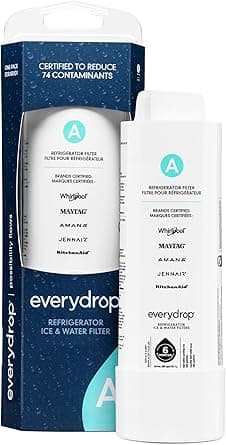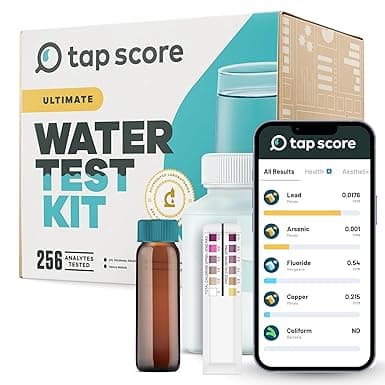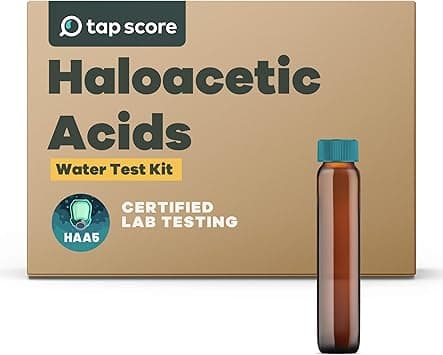New London Tap Water Quality Report
New London's water has 10 contaminants above EPA MCLGs. We recommend using a certified water filter.
Utility
NEW LONDON MUNIC
People Served
1,910
MCL Violations
0
Last Updated
May 3, 2022
Is New London Tap Water Safe to Drink?
New London's water has 10 contaminants above EPA health-based guidelines. We strongly recommend using a certified water filter to reduce exposure to these contaminants. Check our filter recommendations below for NSF-certified options that can remove the specific contaminants found in New London's water.
The data below shows test results from NEW LONDON MUNIC WATER DEPT, which serves 1,910 people in the New London area. Water quality testing is conducted regularly and reported to the EPA. This report was last updated May 3, 2022.
New London Water Quality Test Results
Key Water Quality Metrics
Contaminants Detected
⚠️ Contaminants Above EPA MCLG (10)
Bromodichloromethane
What is Bromodichloromethane?
Member of trihalomethanes (THMs) that form in water treated with chlorine
Health Effects
Health protective benchmarks for BDCM are based on carcinogenicity and liver toxicity observed in animal studies. The EPA has classified BDCM as a probable human carcinogen. Results from animal studies also suggest that kidney, immune system, spleen, and developmental toxicity are associated with exposure to BDCM. BDCM has been shown to produce DNA changes (genotoxicity) in laboratory studies.
Affected Organs
Common Sources
Bromoform
What is Bromoform?
Member of trihalomethanes (THMs) that form in water treated with chlorine
Health Effects
Health protective benchmarks for bromoform are based on liver, developmental, and carcinogenicity observed in animal studies. Results from animal studies also suggest that exposure to bromoform can also lead to liver, kidney, and developmental toxicity. Bromoform has also been shown to produce DNA changes (genotoxicity) in laboratory studies.
Affected Organs
Common Sources
Radium, combined (-226 & -228)
What is Radium, combined (-226 & -228)?
Radium is a naturally occurring radioactive metal that is part of the uranium decay series. It is found in trace amounts in soil, rock, and water. Radium is known for its radioactive properties and can emit alpha, beta, and gamma radiation. It is a heavy metal and can be harmful to human health when ingested or inhaled.
Health Effects
Exposure to radium can lead to serious health issues, including an increased risk of cancer, particularly bone cancer. It can also cause damage to the bone marrow and other organs. Long-term exposure may result in anemia, immune system suppression, and other health complications.
Affected Organs
Common Sources
Dibromoacetic Acid (DBA)
What is Dibromoacetic Acid (DBA)?
Member of haloacetic acids (HAAs) that form as byproducts when chlorine reacts with organic matter
Health Effects
Health protective benchmarks for DBA are based on carcinogenicity and liver toxicity observed in animal studies. The EPA has classified DBA as a probable human carcinogen. Results from animal studies also suggest that kidney, immune system, spleen and developmental toxicity are associated with exposure to BDCM. BDCM has been shown to produce DNA changes (genotoxicity) in laboratory studies.
Affected Organs
Common Sources
Total THMs
What is Total THMs?
Group of contaminants that form in drinking water systems when a disinfectant, typically chlorine, reacts with organic matter
Health Effects
Drinking water standards for total THMs are based on evidence of carcinogenicity in human and animal studies, as well as liver and kidney toxicity observed in animal studies. Individual THMs have been further associated with developmental, immune, spleen, and genotoxicity.
Affected Organs
Common Sources
Radium 226
What is Radium 226?
Radium-226 is a radioactive isotope of radium, which is a naturally occurring element found in uranium ores. It is a decay product of uranium-238 and is known for its radioactive properties, emitting alpha particles and gamma radiation.
Health Effects
Exposure to Radium-226 can lead to serious health issues, including an increased risk of bone cancer and other malignancies. It can accumulate in bones and tissues, leading to long-term health effects due to its radioactivity.
Affected Organs
Common Sources
Dibromochloromethane
What is Dibromochloromethane?
Member of trihalomethanes (THMs) that form in water treated with chlorine
Health Effects
Health protective benchmarks for DBCM have been developed based on liver toxicity and carcinogenicity observed in animal studies. EPA has classified DBCM as a possible human carcinogen based on animal evidence, while IARC (International Agency for Research on Cancer) says it is unclassifiable as a human carcinogen. Kidney toxicity has also been associated with DBCM based on evidence from animal studies. DBCM has been shown to produce DNA changes (genotoxicity) in laboratory studies.
Affected Organs
Common Sources
Radium 228
What is Radium 228?
Radium-228 is a radioactive isotope of radium that occurs naturally in uranium and thorium ores. It is part of the decay chain of uranium-232 and has a half-life of 5.75 years. Radium-228 can be found in groundwater and can contaminate drinking water supplies.
Health Effects
Exposure to radium-228 can lead to an increased risk of cancer, particularly bone cancer, due to its radioactive properties. Long-term exposure can also affect the kidneys and other organs.
Affected Organs
Common Sources
Trichloroacetic Acid (TCA)
What is Trichloroacetic Acid (TCA)?
Member of haloacetic acids (HAAs) that form as byproducts when chlorine reacts with organic matter
Health Effects
Health protective benchmarks for TCA in drinking water have been developed based on liver toxicity and carcinogenicity observed in animal studies. EPA has classified TCA as a possible human carcinogen. Developmental toxicity has also been associated with exposure to TCA based on evidence from animal studies.
Affected Organs
Common Sources
Sodium
What is Sodium?
Sodium is a chemical element with the symbol Na (from Latin 'Natrium') and atomic number 11. It is a soft, silvery-white, highly reactive metal that belongs to the alkali metals group. Sodium is essential for life and is found in many foods, but excessive sodium intake can lead to health issues.
Health Effects
High sodium intake is associated with increased blood pressure, which can lead to cardiovascular diseases. It may also cause kidney damage and increase the risk of stroke.
Affected Organs
Common Sources
Understanding the Data
This data comes from your local water utility testing. The bar charts compare detected levels against EPA's Maximum Contaminant Level Goal (MCLG). Contaminants above the MCLG are shown by default and may require filtration. All other tested contaminants are within safe levels and can be viewed by expanding the section above.
Recommended Water Filters for New London
Based on New London's water quality data, these NSF-certified filters are recommended to remove contaminants above EPA MCLGs.

Solventum Purification Inc.
3MRO401
NSF Certified:
Daily Production
11.48 gpd
Removes 15 contaminants:
Arsenic, Barium, Cadmium, Chromium (Total), Chromium (VI) +10 more

Solventum Purification Inc.
3MRO301
NSF Certified:
Daily Production
11.48 gpd
Removes 15 contaminants:
Arsenic, Barium, Cadmium, Chromium (Total), Chromium (VI) +10 more

Whirlpool Corporation
W11256135
NSF Certified:
Capacity
1001 gal
Filter Life
3 mo
Flow Rate
0.7 gpm
Removes 19 contaminants:
1,2 Dichlorobenzene, 1,4 Dichlorobenzene, 2,4-D, Asbestos, Atrazine +14 more

Whirlpool Corporation
W11569861
NSF Certified:
Capacity
1001 gal
Filter Life
3 mo
Flow Rate
0.52 gpm
Removes 22 contaminants:
1,2 Dichlorobenzene, 1,2,4 Trichlorobenzene, 1,4 Dichlorobenzene, 2,4-D, Asbestos +17 more
Verify Your Water Quality with Independent Testing
With 10 contaminants above EPA health guidelines, independent laboratory testing provides a second opinion and can track changes over time.

SimpleLab
Advanced Home Water Test
$369
Most comprehensive home water test including all standard tests plus additional parameters for ultimate peace of mind.

SimpleLab
Standard Home Water Test
$232
Comprehensive water analysis testing over 200 contaminants including bacteria, heavy metals, and chemical compounds.

Tap Score
Haloacetic Acids (HAA9) Test
$275
Tests for disinfection byproducts formed when chlorine reacts with organic matter in water treatment.
Frequently Asked Questions About New London Tap Water
New London's water has 10 contaminants above EPA MCLGs. We strongly recommend using a certified water filter to reduce exposure to these contaminants. Check our filter recommendations below for NSF-certified options that can remove the specific contaminants found in New London's water.